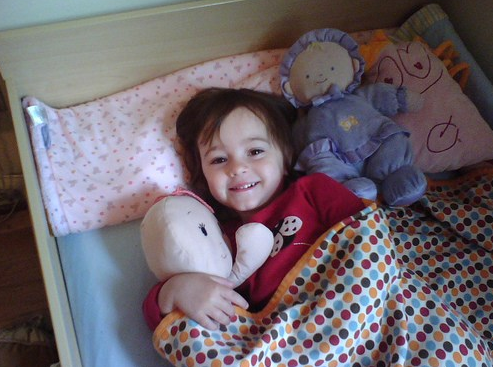Make a smooth move from the crib to the bed
Many families contact me when they move their toddler from a crib to a bed stating that their child slept great when in the crib but now that he is in the bed, it’s a circus all night long. This can be a tough move for some children. Many children are comforted by the familiarity and confinement of the crib and struggle with the loss of boundaries when the rails of the crib are no longer there.
Before moving your child out of the crib, be sure to seriously consider your child’s age and level of cognitive development. There is no reason to rush the move from the crib to the bed. Think about how well your child follows instructions. Does your child have the ability to understand the rules for sleeping in a big bed? Sometimes I hear from parents that their child wasn’t sleeping well in the crib so they thought they would try the bed. Other times there is a new baby on the way and the parents want to use the crib for the baby. Moving your child out of the crib before he is ready can backfire. If your child isn’t sleeping well in the crib and he is under 2½ years old, I would work on helping your child improve his sleep while in the crib before making the move to the bed. If your child doesn’t know how to fall asleep on his own in the crib, this will not become easier in a bed. If a new baby is coming along, consider having the baby sleep in a pack n play or bassinet before moving the baby to your toddler’s former crib.
Once you have determined that your child is ready to make the move, here are some helpful tips to make this transition as smooth as possible.
Let your child be part of the process. Give him choices of new bedding for the bed and, if possible, the actual bed itself.
Consider getting a behavior modification clock. The Good Nite Lite is a very simple one that even young toddlers can understand if they know the difference between the sun and the moon. These clocks won’t work their magic on their own. You, the parent, must reinforce it. That means if your child wakes 10 minutes before the clock changes, you need to remind him that the clock doesn’t say it is time to wake up yet. If you don’t reinforce it, the clock is meaningless.
Sit down and talk to your child about moving into a big bed. Pick a good time when he isn’t tired or hungry and can focus for a couple of minutes. Explain that he is growing up and this is why he is going to be in a big bed but that this also comes with responsibilities.
Make sure you have a good, predictable bedtime routine so that your child knows what is about to happen at bedtime. This is important for any age child. Having a bedtime routine is comforting and helps your child’s brain prepare to go from an awake state to a sleeping state.
Put together a sleep manners chart or a “Beddy-Bye Book.” Both of these are visual ways for your child to understand what happens at bedtime and also what is expected of him. I suggest walking through the bedtime routine with your child and taking photos of him to use for the chart or book. Use positive language in your chart or book to describe what you want to have happen such as “Lay quietly in bed,” “Stay in your bed all night,” “Go back to sleep if you wake up and your wake up light isn’t on,” “Wake up when your clock says it’s okay.”
Talk about your plans for bedtime before, during, and after. Remind your child about your expectations as you are tucking your child in and reinforce their accomplishments first thing in the morning.
Most importantly, be consistent. Toddlers learn VERY quickly what they can and cannot get away with and they will test your limits. Be prepared to reinforce your expectations.
Good luck with your big transition! Your baby is growing up!

